Introduction
Materials and Methods
1. Data sources
2. Classification
3. Statistical analyses
Selected Findings
1. Incidence
Table 1.
| Site/Type |
New cases |
Deaths |
Prevalent casesa) |
||||||
|---|---|---|---|---|---|---|---|---|---|
| Both sexes | Men | Women | Both sexes | Men | Women | Both sexes | Men | Women | |
| All sites | 229,180 | 120,068 | 109,112 | 78,194 | 48,208 | 29,986 | 1,739,951 | 764,103 | 975,848 |
| Lip, oral cavity, and pharynx | 3,543 | 2,527 | 1,016 | 1,203 | 909 | 294 | 23,639 | 15,847 | 7,792 |
| Esophagus | 2,499 | 2,245 | 254 | 1,524 | 1,379 | 145 | 9,777 | 8,780 | 997 |
| Stomach | 30,504 | 20,509 | 9,995 | 8,264 | 5,318 | 2,946 | 273,701 | 181,234 | 92,467 |
| Colon and rectum | 28,127 | 16,672 | 11,455 | 8,358 | 4,659 | 3,699 | 236,431 | 140,852 | 95,579 |
| Liver | 15,771 | 11,774 | 3,997 | 11,001 | 8,044 | 2,957 | 64,864 | 48,666 | 16,198 |
| Gallbladderb) | 6,685 | 3,490 | 3,195 | 4,408 | 2,248 | 2,160 | 21,011 | 10,776 | 10,235 |
| Pancreas | 6,655 | 3,384 | 3,271 | 5,614 | 2,901 | 2,713 | 10,595 | 5,502 | 5,093 |
| Larynx | 1,167 | 1,101 | 66 | 334 | 310 | 24 | 10,532 | 9,914 | 618 |
| Lung | 25,780 | 17,790 | 7,990 | 17,963 | 13,324 | 4,639 | 76,544 | 47,438 | 29,106 |
| Breast | 21,839 | 92 | 21,747 | 2,472 | 16 | 2,456 | 198,006 | 743 | 197,263 |
| Cervix uteri | 3,566 | - | 3,566 | 897 | - | 897 | 52,758 | - | 52,758 |
| Corpus uteri | 2,771 | - | 2,771 | 313 | - | 313 | 23,135 | - | 23,135 |
| Ovary | 2,630 | - | 2,630 | 1,204 | - | 1,204 | 19,509 | - | 19,509 |
| Prostate | 11,800 | 11,800 | - | 1,745 | 1,745 | - | 77,635 | 77,635 | - |
| Testis | 288 | 288 | - | 14 | 14 | - | 3,204 | 3,204 | - |
| Kidney | 5,043 | 3,410 | 1,633 | 1,032 | 724 | 308 | 38,836 | 26,161 | 12,675 |
| Bladder | 4,361 | 3,488 | 873 | 1,389 | 1,029 | 360 | 33,543 | 27,347 | 6,196 |
| Brain and CNS | 2,015 | 1,104 | 911 | 1,327 | 720 | 607 | 11,116 | 5,734 | 5,382 |
| Thyroid | 26,051 | 5,538 | 20,513 | 346 | 104 | 242 | 379,946 | 65,336 | 314,610 |
| Hodgkin lymphoma | 312 | 202 | 110 | 51 | 33 | 18 | 2,807 | 1,770 | 1,037 |
| Non-Hodgkin lymphoma | 4,766 | 2,766 | 2,000 | 1,820 | 1,068 | 752 | 30,093 | 17,130 | 12,963 |
| Multiple myeloma | 1,535 | 837 | 698 | 1,010 | 527 | 483 | 5,798 | 3,050 | 2,748 |
| Leukemia | 3,416 | 1,991 | 1,425 | 1,842 | 1,025 | 817 | 20,751 | 11,553 | 9,198 |
| Other and ill-defined | 18,056 | 9,060 | 8,996 | 4,063 | 2,111 | 1,952 | 115,720 | 55,431 | 60,289 |
Table 2.
| Site/Type |
Crude incidence rate per 100,000 |
Age-standardized incidence rate per 100,000a) |
||||
|---|---|---|---|---|---|---|
| Both sexes | Men | Women | Both sexes | Men | Women | |
| All sites | 448.4 | 470.3 | 426.5 | 269.0 | 298.0 | 254.6 |
| Lip, oral cavity, and pharynx | 6.9 | 9.9 | 4.0 | 4.2 | 6.4 | 2.3 |
| Esophagus | 4.9 | 8.8 | 1.0 | 2.7 | 5.4 | 0.5 |
| Stomach | 59.7 | 80.3 | 39.1 | 34.0 | 49.6 | 20.5 |
| Colon and rectum | 55.0 | 65.3 | 44.8 | 30.7 | 40.4 | 22.4 |
| Liver | 30.9 | 46.1 | 15.6 | 17.6 | 28.5 | 7.8 |
| Gallbladderb) | 13.1 | 13.7 | 12.5 | 6.7 | 8.3 | 5.5 |
| Pancreas | 13.0 | 13.3 | 12.8 | 7.0 | 8.1 | 6.0 |
| Larynx | 2.3 | 4.3 | 0.3 | 1.3 | 2.6 | 0.1 |
| Lung | 50.4 | 69.7 | 31.2 | 27.1 | 42.3 | 15.4 |
| Breast | 42.7 | 0.4 | 85.0 | 27.7 | 0.2 | 54.9 |
| Cervix uteri | 7.0 | 0.0 | 13.9 | 4.6 | - | 9.1 |
| Corpus uteri | 5.4 | 0.0 | 10.8 | 3.4 | - | 6.8 |
| Ovary | 5.1 | 0.0 | 10.3 | 3.4 | - | 6.7 |
| Prostate | 23.1 | 46.2 | 0.0 | 12.5 | 28.2 | - |
| Testis | 0.6 | 1.1 | 0.0 | 0.6 | 1.1 | - |
| Kidney | 9.9 | 13.4 | 6.4 | 6.1 | 8.7 | 3.8 |
| Bladder | 8.5 | 13.7 | 3.4 | 4.5 | 8.4 | 1.6 |
| Brain and CNS | 3.9 | 4.3 | 3.6 | 3.1 | 3.5 | 2.7 |
| Thyroid | 51.0 | 21.7 | 80.2 | 36.6 | 15.6 | 58.1 |
| Hodgkin lymphoma | 0.6 | 0.8 | 0.4 | 0.5 | 0.6 | 0.4 |
| Non-Hodgkin lymphoma | 9.3 | 10.8 | 7.8 | 6.2 | 7.7 | 4.8 |
| Multiple myeloma | 3.0 | 3.3 | 2.7 | 1.7 | 2.0 | 1.4 |
| Leukemia | 6.7 | 7.8 | 5.6 | 5.6 | 6.6 | 4.7 |
| Other and ill-defined | 35.3 | 35.5 | 35.2 | 21.2 | 23.7 | 19.1 |
2. Mortality
Table 3.
| Rank | Cause of death | No. of deaths (%) | Age-standardized death rate per 100,000a) |
|---|---|---|---|
| All causes | 280,827 (100) | 280.8 | |
| 1 | Cancer | 78,194 (27.8) | 79.8 |
| 2 | Heart disease | 9,807 (3.5) | 9.0 |
| 3 | Cerebrovascular disease | 5,416 (1.9) | 4.6 |
| 4 | Pneumonia | 29,735 (10.6) | 27.8 |
| 5 | Intentional self-harm (suicide) | 23,415 (8.3) | 21.4 |
| 6 | Diabetes mellitus | 16,476 (5.9) | 14.3 |
| 7 | Chronic lower respiratory diseases | 6,992 (2.5) | 6.0 |
| 8 | Disease of liver | 6,798 (2.4) | 7.7 |
| 9 | Transport accidents | 5,150 (1.8) | 6.8 |
| 10 | Hypertensive diseases | 13,092 (4.7) | 17.7 |
| Others | 85,752 (30.5) | 85.9 |
Table 4.
| Site/Type |
Crude mortality rate per 100,000 |
Age-standardized mortality rate per 100,000a) |
||||
|---|---|---|---|---|---|---|
| Both sexes | Men | Women | Both sexes | Men | Women | |
| All sites | 153.0 | 188.8 | 117.2 | 79.8 | 115.5 | 53.6 |
| Lip, oral cavity, and pharynx | 2.4 | 3.6 | 1.1 | 1.3 | 2.2 | 0.5 |
| Esophagus | 3.0 | 5.4 | 0.6 | 1.6 | 3.2 | 0.2 |
| Stomach | 16.2 | 20.8 | 11.5 | 8.3 | 12.7 | 5.0 |
| Colon and rectum | 16.4 | 18.3 | 14.5 | 8.2 | 11.1 | 5.9 |
| Liver | 21.5 | 31.5 | 11.6 | 11.7 | 19.2 | 5.2 |
| Gallbladderb) | 8.6 | 8.8 | 8.4 | 4.2 | 5.3 | 3.4 |
| Pancreas | 11.0 | 11.4 | 10.6 | 5.7 | 7.0 | 4.6 |
| Larynx | 0.7 | 1.2 | 0.1 | 0.3 | 0.8 | 0.0 |
| Lung | 35.1 | 52.2 | 18.1 | 17.6 | 31.2 | 7.7 |
| Breast | 4.8 | 0.1 | 9.6 | 2.9 | 0.0 | 5.5 |
| Cervix uteri | 1.8 | 0.0 | 3.5 | 1.0 | - | 1.8 |
| Corpus uteri | 0.6 | 0.0 | 1.2 | 0.4 | - | 0.7 |
| Ovary | 2.4 | 0.0 | 4.7 | 1.3 | - | 2.5 |
| Prostate | 3.4 | 6.8 | 0.0 | 1.5 | 4.2 | - |
| Testis | 0.0 | 0.1 | 0.0 | 0.0 | 0.0 | - |
| Kidney | 2.0 | 2.8 | 1.2 | 1.1 | 1.8 | 0.5 |
| Bladder | 2.7 | 4.0 | 1.4 | 1.3 | 2.5 | 0.5 |
| Brain and CNS | 2.6 | 2.8 | 2.4 | 1.7 | 2.0 | 1.4 |
| Thyroid | 0.7 | 0.4 | 0.9 | 0.3 | 0.2 | 0.4 |
| Hodgkin lymphoma | 0.1 | 0.1 | 0.1 | 0.1 | 0.1 | 0.0 |
| Non-Hodgkin lymphoma | 3.6 | 4.2 | 2.9 | 1.9 | 2.6 | 1.4 |
| Multiple myeloma | 2.0 | 2.1 | 1.9 | 1.0 | 1.2 | 0.9 |
| Leukemia | 3.6 | 4.0 | 3.2 | 2.3 | 2.8 | 1.9 |
| Other and ill-defined | 7.9 | 8.3 | 7.6 | 4.3 | 5.3 | 3.5 |
3. Trends in cancer incidence and mortality
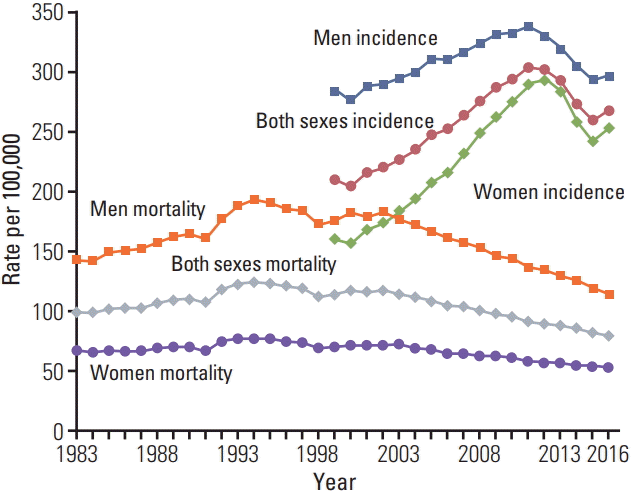 | Fig. 1.Annual age-standardized cancer incidence and death rates by sex for all sites from 1983 to 2016 in Korea. Age standardization was based on the Segi’s world standard population. |
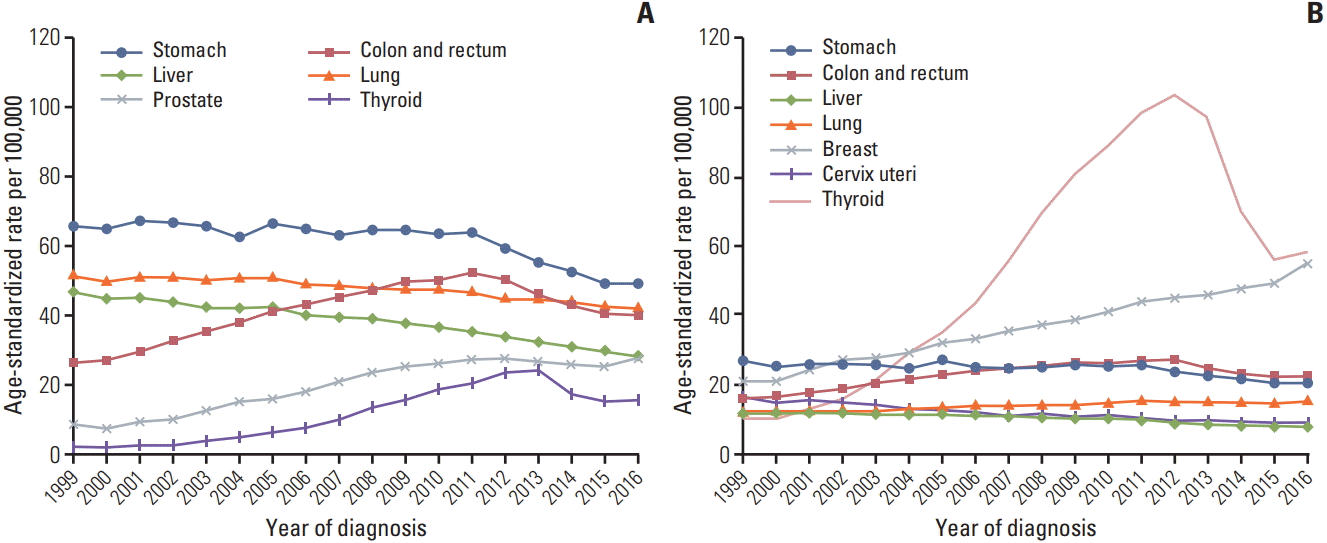 | Fig. 2.Trends in age-standardized incidences of selected cancers by sex from 1999 to 2016 in Korea. (A) Men. (B) Women. Age standardization was based on the Segi’s world standard population. |
Table 5.
| Site/Type |
Both sexes |
Men |
Women |
|||||||||||||||
|---|---|---|---|---|---|---|---|---|---|---|---|---|---|---|---|---|---|---|
| 1999 | 2016 |
Trend 1 |
Trend 2 |
1999 | 2016 |
Trend 1 |
Trend 2 |
1999 | 2016 |
Trend 1 |
Trend 2 |
|||||||
| Year | APC | Year | APC | Year | APC | Year | APC | Year | APC | Year | APC | |||||||
| All sites | 210.5 | 269.0 | 1999-2011 | 3.6a) | 2011-2016 | –3.1a) | 285.0 | 298.0 | 1999-2011 | 1.7a) | 2011-2016 | –3.0a) | 161.1 | 254.6 | 1999-2011 | 5.8a) | 2011-2016 | –3.5a) |
| Lip, oral cavity, and pharynx | 3.6 | 4.2 | 1999-2016 | 0.6a) | - | - | 6.1 | 6.4 | 1999-2016 | –0.1 | - | - | 1.6 | 2.3 | 1999-2016 | 1.5a) | - | - |
| Esophagus | 4.1 | 2.7 | 1999-2016 | –2.2a) | - | - | 8.8 | 5.4 | 1999-2016 | –2.7a) | - | - | 0.6 | 0.5 | 1999-2016 | –1.5a) | - | - |
| Stomach | 43.6 | 34.0 | 1999-2011 | –0.2 | 2011-2016 | –4.9a) | 66.2 | 49.6 | 1999-2011 | –0.4a) | 2011-2016 | –5.4a) | 26.7 | 20.5 | 1999-2011 | –0.4 | 2011-2016 | –4.5a) |
| Colon and rectum | 20.4 | 30.7 | 1999-2010 | 6.0a) | 2010-2016 | –4.5a) | 26.2 | 40.4 | 1999-2010 | 6.5a) | 2010-2016 | –5.0a) | 16.4 | 22.4 | 1999-2010 | 4.9a) | 2010-2016 | –3.9a) |
| Liver | 27.9 | 17.6 | 1999-2010 | –1.7a) | 2010-2016 | –4.4a) | 46.8 | 28.5 | 1999-2009 | –1.9a) | 2009-2016 | –4.1a) | 12.3 | 7.8 | 1999-2010 | –1.5a) | 2010-2016 | –4.8a) |
| Gallbladderb) | 6.5 | 6.7 | 1999-2004 | 1.5 | 2004-2016 | –0.3 | 8.1 | 8.3 | 1999-2016 | 0.1 | - | - | 5.4 | 5.5 | 1999-2003 | 2.4 | 2003-2016 | –0.5a) |
| Pancreas | 5.6 | 7.0 | 1999-2016 | 1.4a) | - | - | 7.8 | 8.1 | 1999-2016 | 0.5a) | - | - | 4.0 | 6.0 | 1999-2016 | 2.3a) | - | - |
| Larynx | 2.3 | 1.3 | 1999-2016 | –3.6a) | - | - | 4.9 | 2.6 | 1999-2016 | –3.8a) | - | - | 0.4 | 0.1 | 1999-2007 | –9.0a) | 2007-2016 | –4.1a) |
| Lung | 28.5 | 27.1 | 1999-2011 | 0.1 | 2011-2016 | –1.4a) | 51.4 | 42.3 | 1999-2005 | –0.1 | 2005-2016 | –1.6a) | 12.4 | 15.4 | 1999-2011 | 2.0a) | 2011-2016 | –0.1 |
| Breast | 10.7 | 27.7 | 1999-2005 | 7.6a) | 2005-2016 | 4.5a) | 0.2 | 0.2 | 1999-2016 | –0.8 | 20.9 | 54.9 | 1999-2005 | 7.8a) | 2005-2016 | 4.6a) | ||
| Cervix uteri | 8.5 | 4.6 | 1999-2016 | –3.8a) | - | - | - | - | - | - | - | - | 16.3 | 9.1 | 1999-2016 | –3.6a) | - | - |
| Corpus uteri | 1.4 | 3.4 | 1999-2003 | 8.8a) | 2003-2016 | 4.6a) | - | - | - | - | - | - | 2.8 | 6.8 | 1999-2003 | 9.1a) | 2003-2016 | 4.7a) |
| Ovary | 2.7 | 3.4 | 1999-2016 | 1.6a) | - | - | - | - | - | - | - | - | 5.0 | 6.7 | 1999-2016 | 1.9a) | - | - |
| Prostate | 3.1 | 12.5 | 1999-2009 | 15.1a) | 2009-2016 | 1.0 | 8.4 | 28.2 | 1999-2009 | 13.5a) | 2009-2016 | 0.2 | - | - | - | - | - | - |
| Testis | 0.3 | 0.6 | 1999-2016 | 4.9a) | - | - | 0.6 | 1.1 | 1999-2016 | 4.7a) | - | - | - | - | - | - | - | - |
| Kidney | 3.0 | 6.1 | 1999-2009 | 6.6a) | 2009-2016 | 1.7a) | 4.5 | 8.7 | 1999-2010 | 6.0a) | 2010-2016 | 0.8 | 1.7 | 3.8 | 1999-2008 | 6.9a) | 2008-2016 | 2.2a) |
| Bladder | 4.6 | 4.5 | 1999-2004 | 2.2a) | 2004-2016 | –1.2a) | 9.0 | 8.4 | 1999-2004 | 2.0a) | 2004-2016 | –1.5a) | 1.6 | 1.6 | 1999-2003 | 2.2 | 2003-2016 | –1.4a) |
| Brain and CNS | 2.9 | 3.1 | 1999-2016 | 0.2 | - | - | 3.2 | 3.5 | 1999-2016 | 0.3 | - | - | 2.6 | 2.7 | 1999-2016 | 0.1 | - | - |
| Thyroid | 6.3 | 36.6 | 1999-2011 | 22.6a) | 2011-2016 | –12.6a) | 2.1 | 15.6 | 1999-2012 | 22.5a) | 2012-2016 | –14.0a) | 10.4 | 58.1 | 1999-2011 | 22.3a) | 2011-2016 | –13.5a) |
| Hodgkin lymphoma | 0.2 | 0.5 | 1999-2016 | 4.0a) | - | - | 0.4 | 0.6 | 1999-2016 | 3.2a) | - | - | 0.1 | 0.4 | 1999-2016 | 5.1a) | - | - |
| Non-Hodgkin lymphoma | 4.3 | 6.2 | 1999-2016 | 2.4a) | - | - | 5.6 | 7.7 | 1999-2016 | 2.0a) | - | - | 3.3 | 4.8 | 1999-2016 | 2.6a) | - | - |
| Multiple myeloma | 1.0 | 1.7 | 1999-2012 | 3.7a) | 2012-2016 | 0.8 | 1.2 | 2.0 | 1999-2012 | 3.5a) | 2012-2016 | 0.5 | 0.8 | 1.4 | 1999-2006 | 6.1a) | 2006-2016 | 2.2a) |
| Leukemia | 4.7 | 5.6 | 1999-2016 | 1.0a) | - | - | 5.5 | 6.6 | 1999-2016 | 1.1a) | - | - | 3.9 | 4.7 | 1999-2016 | 0.8a) | - | - |
| Other and ill-defined | 14.4 | 21.2 | 1999-2007 | 3.6a) | 2007-2016 | 1.7a) | 18.1 | 23.7 | 1999-2016 | 1.9a) | - | - | 11.9 | 19.1 | 1999-2008 | 4.2a) | 2008-2016 | 1.7a) |
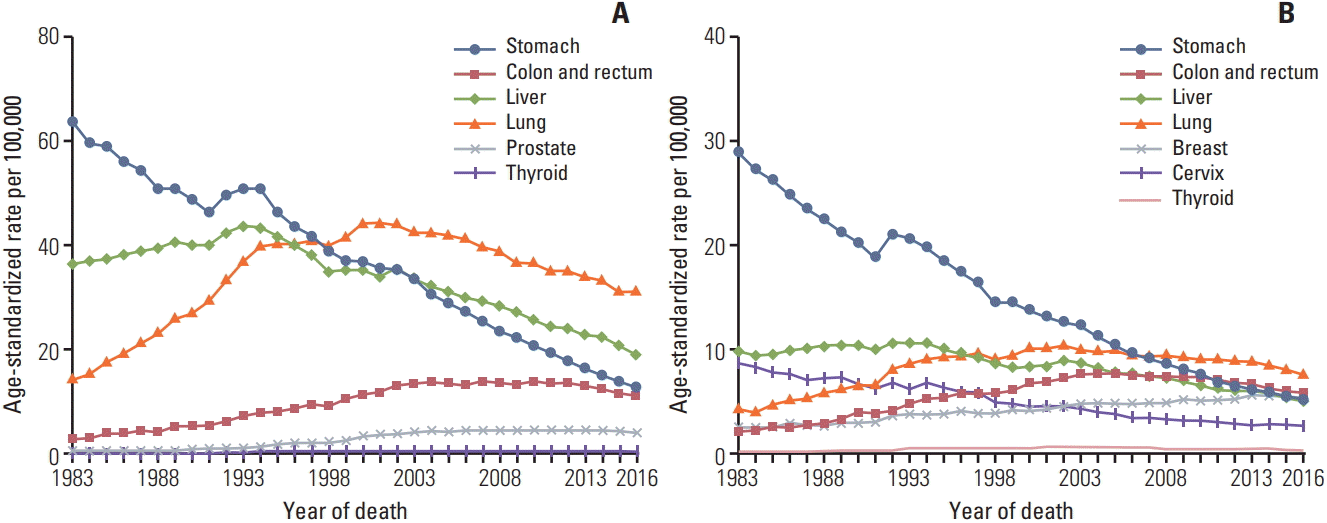 | Fig. 3.Annual age-standardized cancer mortalities of selected cancers by sex from 1983 to 2016 in Korea. (A) Men. (B) Women. Age standardization was based on the Segi’s world standard population. |
Table 6.
| Site/Type |
Both sexes |
Men |
Women |
|||||||||||||||
|---|---|---|---|---|---|---|---|---|---|---|---|---|---|---|---|---|---|---|
| 1999 | 2016 |
Trend 1 |
Trend 2 |
1999 | 2016 |
Trend 1 |
Trend 2 |
1999 | 2016 |
Trend 1 |
Trend 2 |
|||||||
| Year | APC | Year | APC | Year | APC | Year | APC | Year | APC | Year | APC | |||||||
| All sites | 114.3 | 79.8 | 1999-2002 | 1.1 | 2002-2016 | –2.7a) | 176.6 | 115.5 | 1999-2002 | 1.3 | 2002-2016 | –3.2a) | 70.6 | 53.6 | 1999-2002 | 1.0 | 2002-2016 | –2.2a) |
| Lip, oral cavity, and pharynx | 1.1 | 1.3 | 1999-2016 | –1.8a) | - | - | 2.0 | 2.2 | 1999-2016 | –2.0a) | - | - | 0.4 | 0.5 | 1999-2016 | –2.5a) | - | - |
| Esophagus | 3.1 | 1.6 | 1999-2016 | –4.3a) | - | - | 6.8 | 3.2 | 1999-2016 | –4.6a) | - | - | 0.5 | 0.2 | 1999-2010 | –6.4a) | 2010-2016 | –0.6 |
| Stomach | 23.8 | 8.3 | 1999-2003 | –3.2a) | 2003-2016 | –6.7a) | 36.9 | 12.7 | 1999-2003 | –2.5a) | 2003-2016 | –7.1a) | 14.6 | 5.0 | 1999-2003 | –4.4a) | 2003-2016 | –6.6a) |
| Colon and rectum | 7.7 | 8.2 | 1999-2004 | 5.8a) | 2004-2016 | –1.5a) | 10.5 | 11.1 | 1999-2010 | 1.9a) | 2010-2016 | –3.8a) | 6.0 | 5.9 | 1999-2004 | 5.1a) | 2004-2016 | –2.0a) |
| Liver | 20.4 | 11.7 | 1999-2002 | 1.0 | 2002-2016 | –3.8a) | 35.3 | 19.2 | 1999-2002 | 0.2 | 2002-2016 | –3.9a) | 8.3 | 5.2 | 1999-2002 | 2.9 | 2002-2016 | –3.8a) |
| Gallbladderb) | 5.2 | 4.2 | 1999-2001 | 6.9 | 2001-2016 | –2.6a) | 6.8 | 5.3 | 1999-2001 | 5.5 | 2001-2016 | –2.6a) | 4.1 | 3.4 | 1999-2001 | 9.0 | 2001-2016 | –2.6a) |
| Pancreas | 5.4 | 5.7 | 1999-2016 | 0.3a) | - | - | 7.6 | 7.0 | 1999-2016 | –0.4a) | - | - | 3.9 | 4.6 | 1999-2016 | 0.9a) | - | - |
| Larynx | 1.6 | 0.3 | 1999-2016 | –9.5a) | - | - | 3.4 | 0.8 | 1999-2016 | –9.1a) | - | - | 0.4 | 0.0 | 1999-2010 | –15.3a) | 2010-2016 | –8.0a) |
| Lung | 22.4 | 17.6 | 1999-2002 | 1.9 | 2002-2016 | –2.1a) | 41.5 | 31.2 | 1999-2001 | 4.3 | 2001-2016 | –2.5a) | 9.4 | 7.7 | 1999-2002 | 2.6 | 2002-2016 | –1.7a) |
| Breast | 2.2 | 2.9 | 1999-2016 | 1.4a) | - | - | 0.1 | 0.0 | 1999-2016 | –4.3a) | - | - | 4.2 | 5.5 | 1999-2016 | 1.6a) | - | - |
| Cervix uteri | 1.4 | 1.0 | 1999-2003 | 8.3a) | 2003-2016 | –5.1a) | - | - | - | - | - | - | 2.6 | 1.8 | 1999-2003 | 7.7a) | 2003-2016 | –4.8a) |
| Corpus uteri | 0.1 | 0.4 | 1999-2002 | 52.0a) | 2002-2016 | 3.4a) | - | - | - | - | - | - | 0.1 | 0.7 | 1999-2002 | 51.7a) | 2002-2016 | 3.7a) |
| Ovary | 0.9 | 1.3 | 1999-2001 | 10.2 | 2001-2016 | 0.4 | - | - | - | - | - | - | 1.7 | 2.5 | 1999-2006 | 1.0a) | - | - |
| Prostate | 0.9 | 1.5 | 1999-2004 | 9.7a) | 2004-2016 | 0.1 | 2.6 | 4.2 | 1999-2004 | 9.6a) | 2002-2016 | –0.4 | - | - | - | - | - | - |
| Testis | 0.0 | 0.0 | 1999-2016 | –2.6 | - | - | 0.1 | 0.0 | 1999-2016 | –3.1a) | - | - | - | - | - | - | - | - |
| Kidney | 1.1 | 1.1 | 1999-2016 | –0.1 | - | - | 1.8 | 1.8 | 1999-2016 | 0.0 | - | - | 0.5 | 0.5 | 1999-2016 | –0.7 | - | - |
| Bladder | 1.3 | 1.3 | 1999-2011 | 10.0 | 2011-2016 | –1.7a) | 2.6 | 2.5 | 1999-2016 | –1.6a) | - | - | 0.5 | 0.5 | 1999-2001 | 10.3 | 2001-2016 | –1.7a) |
| Brain and CNS | 1.9 | 1.7 | 1999-2002 | 4.2 | 2002-2016 | –1.9a) | 2.2 | 2.0 | 1999-2016 | –1.5a) | - | - | 1.6 | 1.4 | 1999-2016 | –1.4a) | - | - |
| Thyroid | 0.4 | 0.3 | 1999-2003 | 7.4a) | 2003-2016 | –4.4a) | 0.3 | 0.2 | 1999-2003 | 10.3 | 2003-2016 | –4.5a) | 0.5 | 0.4 | 1999-2004 | 4.5 | 2004-2016 | –4.9a) |
| Hodgkin lymphoma | 0.0 | 0.1 | 1999-2004 | 22.5a) | 2004-2016 | –1.4 | 0.0 | 0.1 | 1999-2004 | 19.5a) | 2004-2016 | –2.3 | 0.0 | 0.0 | 1999-2003 | 43.6a) | 2003-2016 | 0.0 |
| Non-Hodgkin lymphoma | 2.1 | 1.9 | 1999-2016 | –0.5a) | - | - | 3.0 | 2.6 | 1999-2016 | –0.8a) | - | - | 1.4 | 1.4 | 1999-2016 | –0.2 | - | - |
| Multiple myeloma | 0.6 | 1.0 | 1999-2003 | 12.7a) | 2003-2016 | 0.9 | 0.8 | 1.2 | 1999-2003 | 11.0a) | 2003-2016 | 0.8 | 0.4 | 0.9 | 1999-2005 | 9.8a) | 2005-2016 | 0.3 |
| Leukemia | 2.9 | 2.3 | 1999-2016 | –1.7a) | - | - | 3.5 | 2.8 | 1999-2016 | –1.6a) | - | - | 2.4 | 1.9 | 1999-2016 | –1.9a) | ||
| Other and ill-defined | 7.8 | 4.3 | 1999-2016 | –3.1a) | - | - | 9.0 | 5.3 | 1999-2008 | –0.3 | 2009-2016 | –5.7a) | 7.0 | 3.5 | 1999-2005 | –7.0a) | 2005-2016 | –2.1a) |
4. Age-specific incidence rates
Table 7.
5. Survival rates
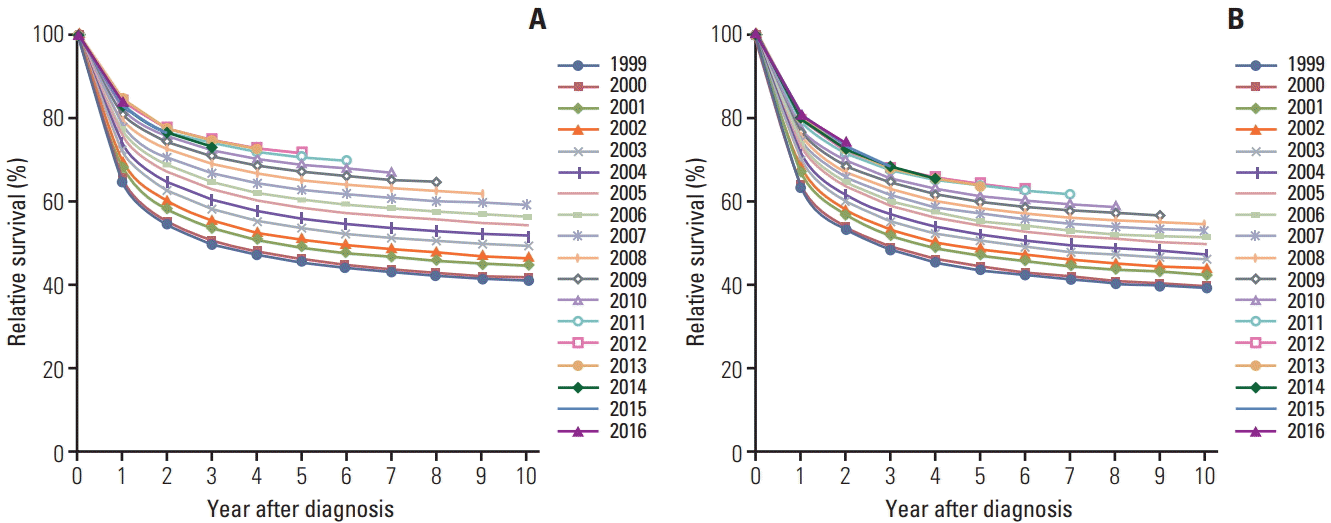 | Fig. 5.Trends in relative survival by year of diagnosis from 1999 to 2016. (A) All sites for both sexes. (B) All sites except thyroid cancer for both sexes. |
Table 8.
| Site/Type |
Both sexes |
Men |
Women |
||||||||||||||||||
|---|---|---|---|---|---|---|---|---|---|---|---|---|---|---|---|---|---|---|---|---|---|
| 1993-1995 | 1996-2000 | 2001-2005 | 2006-2010 | 2011-2015 | 2012-2016 | Changea) | 1993-1995 | 1996-2000 | 2001-2005 | 2006-2010 | 2011-2015 | 2012-2016 | Changea) | 1993-1995 | 1996-2000 | 2001-2005 | 2006-2010 | 2011-2015 | 2012-2016 | Changea) | |
| All sites | 41.2 | 44.0 | 54.0 | 65.2 | 70.7 | 70.6 | 29.4 | 31.7 | 35.3 | 45.4 | 56.6 | 62.9 | 63.2 | 31.5 | 53.4 | 55.3 | 64.2 | 74.3 | 78.3 | 78.0 | 24.6 |
| Lip, oral cavity, and pharynx | 41.1 | 46.7 | 54.3 | 60.8 | 64.9 | 65.4 | 24.3 | 35.8 | 41.1 | 49.5 | 56.7 | 61.3 | 62.1 | 26.3 | 58.1 | 63.8 | 67.9 | 71.8 | 74.2 | 73.9 | 15.8 |
| Esophagus | 12.7 | 15.2 | 21.4 | 29.7 | 36.4 | 37.4 | 24.7 | 11.8 | 14.3 | 20.6 | 29.1 | 36.1 | 37.2 | 25.4 | 23.7 | 24.2 | 29.8 | 36.9 | 39.4 | 39.6 | 15.9 |
| Stomach | 42.8 | 46.6 | 57.8 | 68.1 | 75.7 | 76.0 | 33.2 | 43.0 | 46.9 | 58.5 | 68.8 | 76.6 | 76.9 | 33.9 | 42.6 | 46.0 | 56.5 | 66.8 | 73.8 | 73.9 | 31.3 |
| Colon and rectum | 54.8 | 58.0 | 66.7 | 73.6 | 76.2 | 75.9 | 21.1 | 55.3 | 59.0 | 68.6 | 75.5 | 77.9 | 77.8 | 22.5 | 54.2 | 56.8 | 64.3 | 70.8 | 73.6 | 73.2 | 19.0 |
| Liver | 10.7 | 13.2 | 20.4 | 28.1 | 34.0 | 34.6 | 23.9 | 9.9 | 12.9 | 20.3 | 28.1 | 34.5 | 35.2 | 25.3 | 13.6 | 14.2 | 20.9 | 28.2 | 32.6 | 32.7 | 19.1 |
| Gallbladderb) | 17.3 | 19.7 | 23.0 | 26.7 | 28.8 | 29.0 | 11.7 | 16.6 | 20.3 | 23.4 | 27.6 | 29.5 | 29.7 | 13.1 | 18.0 | 19.1 | 22.6 | 25.8 | 28.0 | 28.3 | 10.3 |
| Pancreas | 9.4 | 7.6 | 8.4 | 8.4 | 10.7 | 11.4 | 2.0 | 8.8 | 7.3 | 8.4 | 8.2 | 10.3 | 11.2 | 2.4 | 10.1 | 8.1 | 8.4 | 8.7 | 11.2 | 11.7 | 1.6 |
| Larynx | 59.7 | 62.3 | 66.2 | 72.8 | 75.2 | 75.7 | 16.0 | 60.2 | 62.8 | 66.8 | 73.1 | 75.7 | 76.3 | 16.1 | 55.4 | 57.8 | 58.5 | 67.7 | 67.9 | 65.8 | 10.4 |
| Lung | 11.3 | 12.7 | 16.5 | 20.1 | 27.1 | 28.2 | 16.9 | 10.4 | 11.6 | 15.2 | 17.9 | 23.0 | 23.7 | 13.3 | 14.2 | 16.2 | 20.1 | 25.8 | 36.5 | 38.6 | 24.4 |
| Breast | 77.9 | 83.2 | 88.6 | 91.1 | 92.5 | 92.7 | 14.8 | 75.1 | 85.6 | 87.2 | 89.5 | 86.3 | 89.3 | 14.2 | 78.0 | 83.2 | 88.6 | 91.1 | 92.6 | 92.7 | 14.7 |
| Cervix uteri | 77.5 | 80.0 | 81.4 | 80.6 | 80.1 | 79.8 | 2.3 | - | - | - | - | - | - | - | 77.5 | 80.0 | 81.4 | 80.6 | 80.1 | 79.8 | 2.3 |
| Corpus uteri | 81.5 | 81.8 | 84.7 | 86.4 | 87.8 | 87.5 | 6.0 | - | - | - | - | - | - | - | 81.5 | 81.8 | 84.7 | 86.4 | 87.8 | 87.5 | 6.0 |
| Ovary | 58.7 | 58.9 | 61.6 | 61.1 | 63.9 | 64.0 | 5.3 | - | - | - | - | - | - | - | 58.7 | 58.9 | 61.6 | 61.1 | 63.9 | 64.0 | 5.3 |
| Prostate | 55.9 | 67.2 | 80.4 | 91.1 | 94.0 | 93.9 | 38.0 | 55.9 | 67.2 | 80.4 | 91.1 | 94.0 | 93.9 | 38.0 | - | - | - | - | - | - | - |
| Testis | 85.4 | 90.4 | 90.7 | 93.1 | 95.3 | 95.2 | 9.8 | 85.4 | 90.4 | 90.7 | 93.1 | 95.3 | 95.2 | 9.8 | - | - | - | - | - | - | - |
| Kidney | 62.0 | 66.1 | 73.5 | 78.3 | 82.3 | 82.7 | 20.7 | 60.8 | 64.4 | 72.9 | 78.2 | 81.8 | 82.5 | 21.7 | 64.5 | 69.7 | 74.8 | 78.7 | 83.3 | 83.1 | 18.6 |
| Bladder | 69.1 | 73.1 | 75.7 | 76.6 | 76.0 | 76.0 | 6.9 | 70.0 | 74.8 | 77.4 | 78.6 | 77.9 | 78.0 | 8.0 | 65.5 | 66.3 | 68.8 | 68.6 | 68.1 | 68.1 | 2.6 |
| Brain and CNS | 38.5 | 39.0 | 41.0 | 42.8 | 41.1 | 41.4 | 2.9 | 37.2 | 37.5 | 40.2 | 41.3 | 39.4 | 39.3 | 2.1 | 40.2 | 40.7 | 41.8 | 44.4 | 43.1 | 43.9 | 3.7 |
| Thyroid | 94.2 | 94.9 | 98.3 | 99.9 | 100.2 | 100.2 | 6.0 | 87.2 | 89.5 | 95.9 | 100.0 | 100.6 | 100.5 | 13.3 | 95.4 | 95.9 | 98.7 | 99.9 | 100.1 | 100.1 | 4.7 |
| Hodgkin lymphoma | 68.0 | 71.2 | 76.6 | 80.9 | 82.3 | 83.0 | 15.0 | 67.6 | 68.1 | 74.6 | 80.7 | 82.2 | 81.9 | 14.3 | 68.6 | 77.4 | 80.7 | 81.4 | 82.5 | 85.0 | 16.4 |
| Non-Hodgkin lymphoma | 46.6 | 50.8 | 55.9 | 59.3 | 62.7 | 63.1 | 16.5 | 45.3 | 48.9 | 54.9 | 59.0 | 62.7 | 63.2 | 17.9 | 48.7 | 53.5 | 57.4 | 59.6 | 62.8 | 63.0 | 14.3 |
| Multiple myeloma | 22.1 | 19.8 | 29.6 | 34.9 | 41.1 | 41.9 | 19.8 | 21.1 | 17.8 | 29.7 | 35.0 | 40.3 | 40.3 | 19.2 | 23.3 | 22.1 | 29.4 | 34.8 | 41.9 | 43.6 | 20.3 |
| Leukemia | 26.5 | 33.3 | 41.9 | 47.6 | 51.5 | 51.9 | 25.4 | 26.2 | 32.3 | 41.8 | 46.9 | 51.8 | 52.5 | 26.3 | 26.8 | 34.6 | 42.2 | 48.6 | 51.1 | 51.1 | 24.3 |
| Other and ill-defined | 42.1 | 45.9 | 57.6 | 67.2 | 72.4 | 73.3 | 31.2 | 37.4 | 42.4 | 53.8 | 63.4 | 69.1 | 70.1 | 32.7 | 47.4 | 50.0 | 61.7 | 71.1 | 75.7 | 76.4 | 29.0 |
6. Prevalence rates
Table 9.
| Site/Type |
Crude prevalence rate per 100,000a) |
Age-standardized prevalence rate per 100,000b) |
||||
|---|---|---|---|---|---|---|
| Both sexes | Men | Women | Both sexes | Men | Women | |
| All sites | 3,404.1 | 2,993.2 | 3,814.1 | 2,046.2 | 1,896.1 | 2,281.5 |
| Lip, oral cavity, and pharynx | 46.2 | 62.1 | 30.5 | 28.2 | 39.7 | 18.2 |
| Esophagus | 19.1 | 34.4 | 3.9 | 10.5 | 20.9 | 1.9 |
| Stomach | 535.5 | 709.9 | 361.4 | 297.8 | 433.6 | 185.7 |
| Colon and rectum | 462.6 | 551.8 | 373.6 | 254.8 | 338.9 | 186.9 |
| Liver | 126.9 | 190.6 | 63.3 | 74.7 | 119.1 | 34.6 |
| Gallbladderc) | 41.1 | 42.2 | 40.0 | 21.8 | 25.6 | 18.9 |
| Pancreas | 20.7 | 21.6 | 19.9 | 11.9 | 13.5 | 10.6 |
| Larynx | 20.6 | 38.8 | 2.4 | 11.2 | 23.6 | 1.2 |
| Lung | 149.8 | 185.8 | 113.8 | 82.7 | 113.6 | 58.9 |
| Breast | 387.4 | 2.9 | 771.0 | 239.0 | 1.8 | 470.0 |
| Cervix uteri | 103.2 | - | 206.2 | 62.6 | - | 122.3 |
| Corpus uteri | 45.3 | - | 90.4 | 28.0 | - | 55.1 |
| Ovary | 38.2 | - | 76.3 | 25.5 | - | 50.6 |
| Prostate | 151.9 | 304.1 | - | 76.1 | 180.5 | - |
| Testis | 6.3 | 12.6 | - | 5.7 | 11.1 | - |
| Kidney | 76.0 | 102.5 | 49.5 | 46.3 | 65.8 | 29.0 |
| Bladder | 65.6 | 107.1 | 24.2 | 34.4 | 65.2 | 10.9 |
| Brain and CNS | 21.7 | 22.5 | 21.0 | 18.3 | 19.5 | 17.1 |
| Thyroid | 743.3 | 255.9 | 1,229.7 | 487.5 | 171.0 | 801.9 |
| Hodgkin lymphoma | 5.5 | 6.9 | 4.1 | 4.5 | 5.5 | 3.5 |
| Non-Hodgkin lymphoma | 58.9 | 67.1 | 50.7 | 40.8 | 49.1 | 33.1 |
| Multiple myeloma | 11.3 | 11.9 | 10.7 | 6.4 | 7.3 | 5.7 |
| Leukemia | 40.6 | 45.3 | 36.0 | 37.4 | 41.8 | 33.0 |
| Other and ill-defined | 226.4 | 217.1 | 235.6 | 139.9 | 149.0 | 132.6 |
a) Crude prevalence rate: number of prevalent cases divided by the corresponding person-years of observation. Prevalent cases were defined as patients who were diagnosed between January 1, 1999 and December 31, 2016 and who were alive on January 1, 2017. Multiple primary cancer cases were counted multiple times,




 PDF
PDF Citation
Citation Print
Print


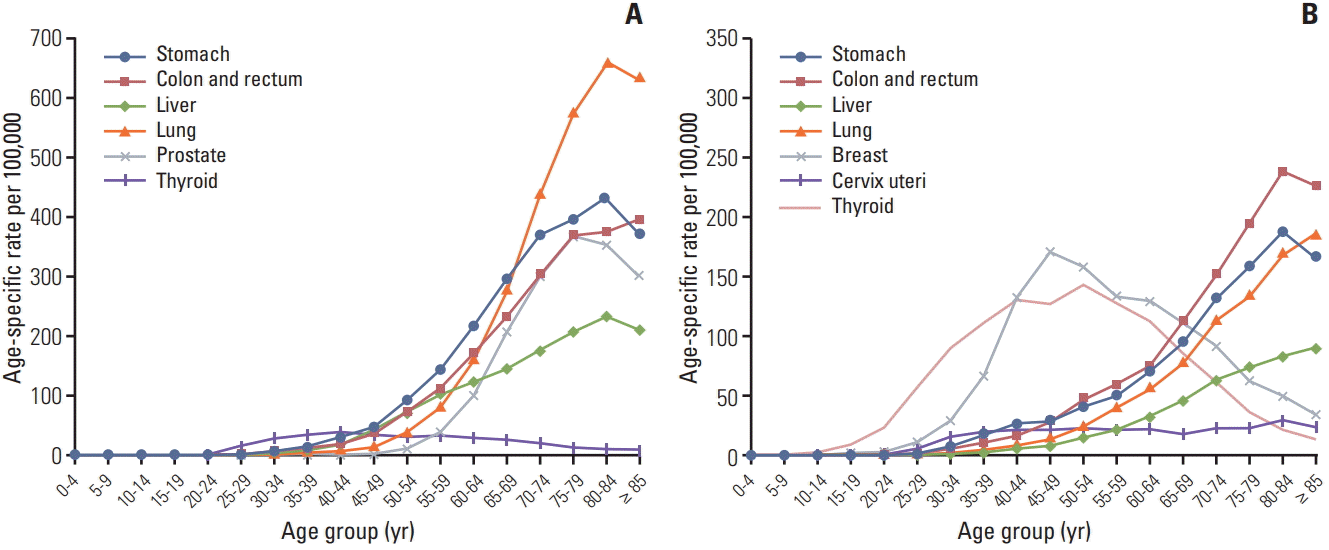
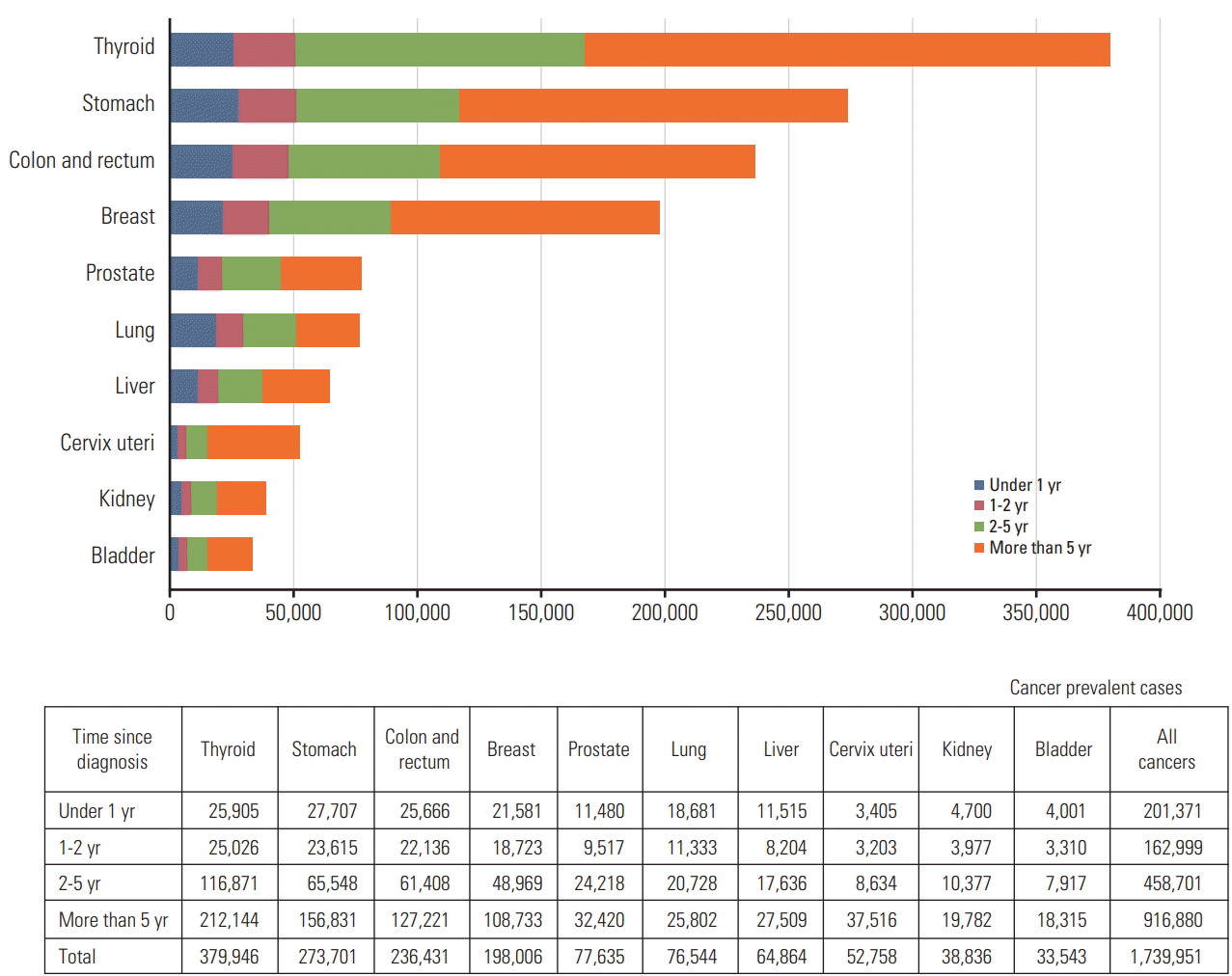
 XML Download
XML Download